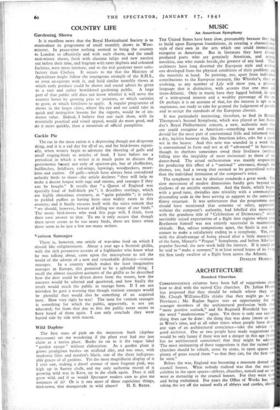ARCHITECTURE Bombed Churches
CORRESPONDENCE columns have been full of suggestions abo how to deal with the ruined City churches. Dr. Julian Huxl has proposed that they should be rebuilt where they are Mr. Clough Williams-Ellis thinks that they might go to t Provinces ; Mr. Raglan Squire sees an opportunity for younger members of the architectural profession with th " more positive outlook," and Sir Reginald Blomfield has us the word "modemismus " again. Yet there is only one sexist thing than can be done: the thing that was done (more or le in Wren's time, and at all other times when people have show any sign of an architectural conscience—take the advice of good architect. One or two people have made suggestions would be only funny if there was not a danger in this age (vs h has no architectural conscience) that they might be adop The most insinuating of these suggestions is that the ruined Ci churches should be rebuilt, stone by stone, in open spaces w*: plenty of grass round them " so that they can, for the first be seen."
Before the war, England was becoming a museum dotted WI council houses. What nobody realised was that the muse exhibits in the open spaces—abbeys, churches, tumuli and so o were as menacing as the council houses. For they were dy and being embalmed. For years the Office of Works has h taking the ivy off the ruined walls of abbeys and castles, sho
fragments of cloisters and keeps, levelling and mowing the is round them and infecting the remains with litter-baskets
d turnstiles—a labour of no love except archaeological love, riled out with the deadening hand of supposed good taste. Protection and repairs are necessary," they said, " in these urist days. Otherwise people would remove the stonework." ecessary or not, the result is that most of these ancient onuments have died: they have lost all their relevance and all ea- beauty. They are now monuments of nothing but arrested caw, symbols of nothing but arrested taste.
The City churches were designed to stand among city build- gs. Wholesale warehouses, towering offices and skysigns may t be ideal neighbours for them, but they are a good deal arer the mark than level sweeps of grass. The Wren churches re designed by a genius for particular sites, and like all good ildings they belong to those sites. They were beautiful and iceable once ; rebuilt, they might conceivably be both those lugs again in time ; removed to open spaces they would at e be follies, their only virtue an appeal to the museum- nded.
Among several burnt-out churches in a much-bombed West untry town there are two whose ruins are very tragic. One ood on a hill-top among terraces of charming stucco houses. was planned to agree with them in style, and was built about o years ago. Its architect showed an ardour and a conviction at we ought to envy. Another, at the other end of .the town, as built less than fifty years ago, and was of a highly original sign which included a fanciful spire, a wide apse and zantine details. Both these churches had large congregations, "good taste " had decided against them—" good taste " that ows the building of sham-Tudor houses in Cornwall and am-Cotswold manors in Surrey. The ruins are tragic because ey have missed their day by ten or fifteen years. Very likely
that time they would have been visited as masterpieces. oday they are mourned by very few people beyond their cumbents and their congregations. Taste in architecture is msier than the most temporary wooden shack. The man to k about the rebuilding or replanning of bombed churches hether they were mediaeval, or by Wren, or by Sir Gilbert ott, is not the man in the street nor the committee-man nor he Times correspondent, but a good ecclesiastical architect. e will very likely be broken (even if he has the genius of ren and the tenacity of John Nash) in trying to get his own ay, but he is bound to be chosen in the end—and, when he
s been, it would be better to leave him alone.
JOHN PIPER.































 Previous page
Previous page